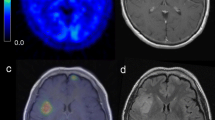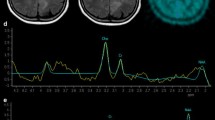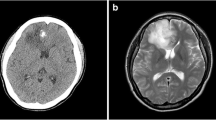Abstract
Purpose
Previous radiological investigations have generally shown the superiority of metabolic imaging in distinguishing high-grade from low-grade glioma, but the presence of an oligodendroglial component may affect the diagnostic accuracy. We investigated the diagnostic accuracy of PET imaging using 11C-methionine (MET) and 18F-fluorodeoxyglucose (FDG) in distinguishing high-grade from low-grade glioma, in correlation with the oligodendroglial component.
Methods
The study population comprised adult patients who underwent preoperative PET imaging using both MET and FDG within 1 week and successful excision of the tumour tissue, which confirmed WHO grade II–IV glioma. We examined the tumour metabolic activity in terms of lesion-to-normal uptake ratios (L/N ratio) in both MET PET and FDG PET images. We assessed the correlation between the imaging results and the histological findings to determine the diagnostic accuracy of receiver operating characteristics (ROC) analysis in detecting high-grade tumours.
Results
We studied 46 patients with glioma (13 low-grade and 33 high-grade), including 26 with an oligodendroglial components. The L/N ratios of the PET images showed significantly higher metabolic activities in high-grade gliomas than in low-grade gliomas for both MET (4.29 ± 1.22 and 2.36 ± 0.72, respectively; p < 0.0001) and FDG (1.72 ± 0.91 and 0.77 ± 0.26, respectively; p = 0.0007) images, although significant overlaps in L/N ratio were observed between high-grade and low-grade gliomas. Excluding the 26 patents with an oligodendroglial component improved the separation for both MET (4.62 ± 1.14 vs. 2.16 ± 0.63; p < 0.001) and FDG (1.76 ± 0.87 vs. 0.71 ± 0.14; p < 0.05) images. The ROC analyses demonstrated the clinical utility of the metabolic radiotracers in distinguishing high-grade from low-grade gliomas, showing similar AUC values for MET (0.91) and FDG (0.92). Excluding the 26 patents with an oligodendroglial component also further improved the diagnostic accuracy for both MET (AUC 0.98), and FDG (AUC 1.00) images. The metabolic radiotracers were significantly correlated with the MIB-1 labelling index (R = 0.52, p < 0.05 for MET; R = 0.52, p < 0.05, for FDG) only in gliomas without an oligodendroglial component.
Conclusion
For better characterization of gliomas and for risk assessment, the results of metabolic PET imaging should be revised after obtaining the pathological report, because oligodendroglial differentiation may positively influence the substrate metabolism and thus complicated the preoperative evaluation.





Similar content being viewed by others
References
Pirotte B, Goldman S, Dewitte O, Massager N, Wikler D, Lefranc F, et al. Integrated positron emission tomography and magnetic resonance imaging-guided resection of brain tumors: a report of 103 consecutive procedures. J Neurosurg. 2006;104(2):238–53.
Yamamoto Y, Nishiyama Y, Kimura N, Kameyama R, Kawai N, Hatakeyama T, et al. 11C-acetate PET in the evaluation of brain glioma: comparison with 11C-methionine and 18F-FDG-PET. Mol Imaging Biol. 2008;10(5):281–7.
De Witte O, Goldberg I, Wikler D, Rorive S, Damhaut P, Monclus M, et al. Positron emission tomography with injection of methionine as a prognostic factor in glioma. J Neurosurg. 2001;95(5):746–50.
Herholz K, Holzer T, Bauer B, Schröder R, Voges J, Ernestus RI, et al. 11C-methionine PET for differential diagnosis of low-grade gliomas. Neurology. 1998;50(5):1316–22.
Kato T, Shinoda J, Oka N, Miwa K, Nakayama N, Yano H, et al. Analysis of 11C-methionine uptake in low-grade gliomas and correlation with proliferative activity. AJNR Am J Neuroradiol. 2008;29(10):1867–71.
Nojiri T, Nariai T, Aoyagi M, Senda M, Ishii K, Ishiwata K, et al. Contributions of biological tumor parameters to the incorporation rate of L-[methyl-11C] methionine into astrocytomas and oligodendrogliomas. J Neurooncol. 2009;93(2):233–41.
Dähnert W. Radiology review manual (Dahnert, Radiology review manual). Philadelphia, Pa: Lippincott Williams & Wilkins; 2011.
Yamaguchi S, Kobayashi H, Hirata K, Shiga T, Tanaka S, Murata J, et al. Detection of histological anaplasia in gliomas with oligodendroglial components using positron emission tomography with (18)F-FDG and (11)C-methionine: report of two cases. J Neurooncol. 2011;101(2):335–41.
Burger P, Scheithauer B. Diagnostic pathology: neuropathology. Philadelphia, Pa: Lippincott Williams & Wilkins; 2012. p. 800.
Hirata K, Terasaka S, Shiga T, Hattori N, Magota K, Kobayashi H, et al. 18F-Fluoromisonidazole positron emission tomography may differentiate glioblastoma multiforme from less malignant gliomas. Eur J Nucl Med Mol Imaging. 2012;39(5):760–70.
Delbeke D, Videlefsky S, Patton JA, Campbell MG, Martin WH, Ohana I, et al. Rest myocardial perfusion/metabolism imaging using simultaneous dual-isotope acquisition SPECT with technetium-99m-MIBI/fluorine-18-FDG. J Nucl Med. 1995;36(11):2110–9.
Chung JK, Kim YK, Kim SK, Lee YJ, Paek S, Yeo JS, et al. Usefulness of 11C-methionine PET in the evaluation of brain lesions that are hypo- or isometabolic on 18F-FDG PET. Eur J Nucl Med Mol Imaging. 2002;29(2):176–82.
Nariai T, Tanaka Y, Wakimoto H, Aoyagi M, Tamaki M, Ishiwata K, et al. Usefulness of L-[methyl-11C]methionine-positron emission tomography as a biological monitoring tool in the treatment of glioma. J Neurosurg. 2005;103(3):498–507.
Sadeghi N, Salmon I, Decaestecker C, Levivier M, Metens T, Wikler D, et al. Stereotactic comparison among cerebral blood volume, methionine uptake, and histopathology in brain glioma. AJNR Am J Neuroradiol. 2007;28(3):455–61.
Sasaki M, Kuwabara Y, Yoshida T, Nakagawa M, Fukumura T, Mihara F, et al. A comparative study of thallium-201 SPET, carbon-11 methionine PET and fluorine-18 fluorodeoxyglucose PET for the differentiation of astrocytic tumours. Eur J Nucl Med. 1998;25(9):1261–9.
Sato N, Suzuki M, Kuwata N, Kuroda K, Wada T, Beppu T, et al. Evaluation of the malignancy of glioma using 11C-methionine positron emission tomography and proliferating cell nuclear antigen staining. Neurosurg Rev. 1999;22:210–4.
Shinozaki N, Uchino Y, Yoshikawa K, Matsutani T, Hasegawa A, Saeki N, et al. Discrimination between low-grade oligodendrogliomas and diffuse astrocytoma with the aid of 11C-methionine positron emission tomography. J Neurosurg. 2011;114(6):1640–7.
Ceyssens S, Van Laere K, de Groot T, Goffin J, Bormans G, Mortelmans L. [11C]methionine PET, histopathology, and survival in primary brain tumors and recurrence. AJNR Am J Neuroradiol. 2006;27(7):1432–7.
Galldiks N, Kracht LW, Berthold F, Miletic H, Klein JC, Herholz K, et al. [11C]-L-methionine positron emission tomography in the management of children and young adults with brain tumors. J Neurooncol. 2010;96(2):231–9.
Torii K, Tsuyuguchi N, Kawabe J, Sunada I, Hara M, Shiomi S. Correlation of amino-acid uptake using methionine PET and histological classifications in various gliomas. Ann Nucl Med. 2005;19(8):677–83.
Christov C, Adle-Biassette H, Le Guerinel C, Natchev S, Gherardi RK. Immunohistochemical detection of vascular endothelial growth factor (VEGF) in the vasculature of oligodendrogliomas. Neuropathol Appl Neurobiol. 1998;24(1):29–35.
Saito T, Maruyama T, Muragaki Y, Tanaka M, Nitta M, Shinoda J, et al. 11C-methionine uptake correlates with combined 1p and 19q loss of heterozygosity in oligodendroglial tumors. AJNR Am J Neuroradiol. 2013;34(1):85–91.
Coons SW, Johnson PC. Regional heterogeneity in the DNA content of human gliomas. Cancer. 1993;72(10):3052–60.
Kim S, Chung JK, Im SH, Jeong JM, Lee DS, Kim DG, et al. 11C-methionine PET as a prognostic marker in patients with glioma: comparison with 18F-FDG PET. Eur J Nucl Med Mol Imaging. 2005;32(1):52–9.
Jackson RJ, Fuller GN, Abi-Said D, Lang FF, Gokaslan ZL, Shi WM, et al. Limitations of stereotactic biopsy in the initial management of gliomas. Neuro Oncol. 2001;3(3):193–200.
Ino Y, Betensky RA, Zlatescu MC, Sasaki H, Macdonald DR, Stemmer-Rachamimov AO, et al. Molecular subtypes of anaplastic oligodendroglioma: implications for patient management at diagnosis. Clin Cancer Res. 2001;7(4):839–45.
Acknowledgments
We thank Shigeo Oomagari, MSc, and Eriko Suzuki for their support.
Compliance with ethical standards
All procedures performed in studies involving human participants were in accordance with the ethical standards of the institutional and/or national research committees and with the principles of the 1964 Declaration of Helsinki and its later amendments or comparable ethical standards. Informed consent was obtained from all individual participants included in the study.
Financial support
None.
Conflicts of interest
None.
Author information
Authors and Affiliations
Corresponding author
Rights and permissions
About this article
Cite this article
Manabe, O., Hattori, N., Yamaguchi, S. et al. Oligodendroglial component complicates the prediction of tumour grading with metabolic imaging. Eur J Nucl Med Mol Imaging 42, 896–904 (2015). https://doi.org/10.1007/s00259-015-2996-7
Received:
Accepted:
Published:
Issue Date:
DOI: https://doi.org/10.1007/s00259-015-2996-7




